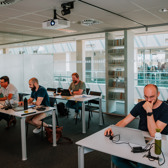Scripting with PowerShell
UPSHELL
3 days
Interested in a private company training? Request it here.
Not ready to book yet? Request an offer here.
PowerShell Overview
PowerShell was first introduced in 2008 as a scripting language for Windows Server. Over the years it has evolved to an open-source, cross platform solution that can be used on Windows, Linux and macOS.
- PowerShell Overview
- Brushing up on objects
- PowerShell Versions
- Windows PowerShell versus PowerShell
- Concepts and Terminology
- Getting Commands
- Getting Help
- Providers and Drives
- LAB: PowerShell Overview
PowerShell Shells
The Windows PowerShell Integrated Scripting Environment (ISE) is a script editor for Windows PowerShell that allows you to run commands and write, test, and debug scripts in a single graphical interface. In addition to the PowerShell ISE, PowerShell is also well-supported in Visual Studio Code with rich intellisense and advanced debugging features.
- PowerShell Console
- Integrated Scripting Environment (ISE)
- Visual Studio Code
- LAB:PowerShell Shells
Core Concepts
Using the pipe operator in PowerShell you can easily perform complex operations in a single line of code. Format cmdlets can be used to change the default output of a command and the Out comdlets allow you to send data to a text file or grid.
- Viewing Object Structure
- Object Pipeline
- Using Format Cmdlets to Change Output
- Export Data with Out Cmdlets
- Using Variables to Store Objects
- LAB: Core Concepts
Object Pipeline Processing
PowerShell contains a bunch of commands that allow you to manipulate your objects using the pipeline. These cmdlets will help you to filter, sort, group, ... any object.
- Where-Object
- Foreach-Object
- Select-Object
- Sort-Object
- Measure-Object
- Compare-Object
- Group-Object
- Tee-Object
- LAB: Object Pipeline Processing
Working with Objects
PowerShell works mostly with .NET objects but also provides full access to COM and WMI.
- Files and Folders
- Registry Keys and Values
- COM Objects
- WMI Objects - CIMCmdlets
- .NET Objects
- Static Classes
- LAB: Working with Objects
Extending PowerShell Functionality
A module is a set of related PowerShell functionalities, grouped together as a convenient unit. To manage different services the correct modules must be downloaded and installed on your machine.
- Modules
- PowerShellGet and the PowerShell Gallery
- PowerShell Profiles
- Operators and Expressions
- LAB: Extending PowerShell Functionality
PowerShell Security
The execution policy is part of the security strategy of PowerShell. It determines whether you can load configuration files and run scripts, and it determines which scripts, if any, must be digitally signed before they will run.
- PowerShell Execution Policy
- Script Signing
- Security Sensitive Information in Scripts
- LAB: PowerShell Security
PowerShell Remoting
PowerShell Remoting lets you run PowerShell commands or access full PowerShell sessions on remote systems.
- PowerShell Remoting Overview
- WS-Management (WSMAN)
- Remote CIM Sessions
- Import/Export Remoting Sessions
- WinRM Security
- WinRM Double Hop Problem
- Using Variables in Remoting Sessions
- LAB: PowerShell Remoting
PowerShell Jobs
Jobs are long-running tasks that are executed in the background. You don't have to wait for the job to finish and can perform other tasks while the job is running. Once completed, the job output can be retrieved. Jobs can be executed on a remote system or they can be scheduled.
- Background Jobs
- Remoting Jobs
- Scheduled Jobs
- LAB:PowerShell Jobs
Managing Your Environment
The goal of PowerShell is to ease your work as an administrator. In this module we will talk about basic management tasks that you need to perform and how you can accomplish these through PowerShell. Configuring network settings, implementing security on files and folders, managing Active Directory.
- Networking
- File Shares
- Data Import
- Security
- Server Management
- Active Directory
- Certificates
- LAB: Managing Your Environment
PowerShell is a powerful tool for automating tasks and managing systems across different platforms. In this course you will learn to work with objects, connect to remote systems and write basic scripts. PowerShell can be used to manage your on-prem systems as well as many cloud services like Entra ID, Intune and Microsoft 365.
If you are interested in advanced scripting techniques and error handling, we recommend you to follow our 5-day course Mastering PowerShell.
This course is intended for:
- System Administrators or System Engineers who are responsible for the management and configuration of multiple Servers and Microsoft applications.
- System Administrators or System Engineers who are responsible for the deployment and maintenance of a Microsoft Cloud Infrastructure.
- Developers interested in automation of test environments, interfacing with C#, embedding PowerShell in their application.











